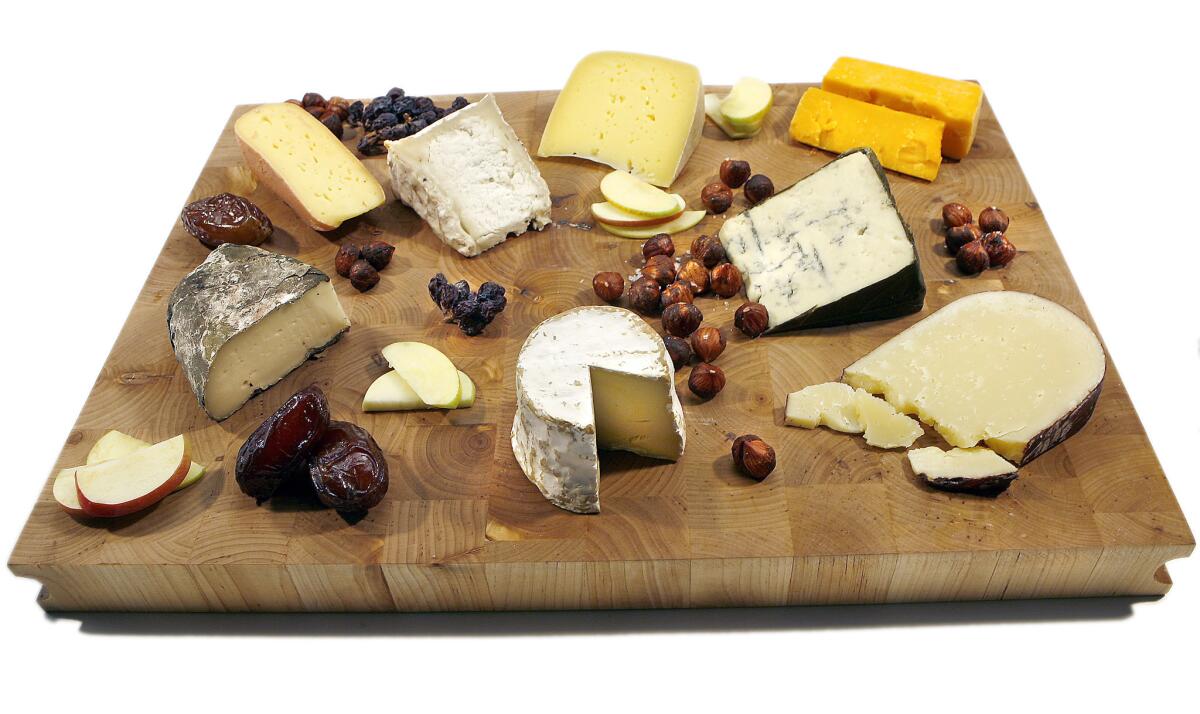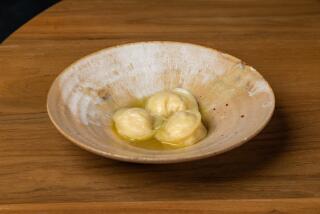The perfect cheese platter for Thanksgiving

Some good choices for a cheese platter (from top, clockwise): Trail Head cow’s milk Washington; Hook’s Cheddar; Rogue River Blue; Vella Dry Hack; Jasper Hills Farm Constant Bliss; Sally Jackson; Grayson; and finally, Truffle Tremor.
Why isn’t cheese a bigger player in the Thanksgiving meal (other than the fact that there probably wasn’t much of it in 17th century Plymouth)? Thanksgiving is the perfect opportunity to serve cheese, for reasons both lofty and practical. The lofty reason is seasonality, because this is arguably the best time of year for cheese. And the practical reason is convenience, because cheese doesn’t require an oven.
Sure, in many ways, cheese is easy -- that’s the point. There is little preparation between removing it from the refrigerator and placing it on a platter. No trussing, no marinating, no julienning.
And you won’t need to impinge on much of your host’s kitchen time or equipment (bring your own platter or board). It’s also an easy last-minute option.
But there’s an art to the cheese course, and some forethought ought to be applied. What kinds of cheeses? How many cheeses? How much to serve as an appetizer? (Serving cheese as an appetizer instead of as an after-dinner course is copacetic -- especially when people are crying out for pie even before their turkey-dinner plates have been cleared.) How best to serve them? With what kind of accompaniments?
Because Thanksgiving is a North American holiday, it seems only logical to focus on North American cheeses. American cheese makers are producing farmhouse or artisanal blue cheese, cheddar, triple-crème, Alpine-style, goat, sheep’s milk, soft-ripened, super-aged. . . . Even the category of soft, washed-rind cheeses has expanded recently; these are the smelly (in a good way) cheeses whose rinds have been rubbed or brushed with brine, wine, spirits or beer to promote desirable mold.
Plus, fall is the season for cheese -- “a season when it’s almost hard to find a cheese that’s not in good form,” writes Max McCalman, maître fromager and author of “The Cheese Plate.” This is prime time for fairly young cheeses that have been aged 60 to 90 days, made from the milk of animals that fed on late summer’s lush pastures. Think Livarot or Munster. Longer-aged cheeses are peaking in flavor too -- such as glorious Alpines (this is when I start craving Appenzeller, or Pleasant Ridge Reserve). And seasonal domestics such as Hope Farm’s Tomme de Brebis or Rogue Creamery’s Rogue River Blue are get-them-while-you-can good.
With so many cheeses to choose from, what should you put on your platter? Some aficionados say to serve no more than three or four at a time, but it wouldn’t be out of line to put out more than a few. Hey, it’s Thanksgiving. Because this is an appetizer course and there will be no dearth of food, I’d serve just one-half ounce of each cheese per person. For eight people, for example, you’d need just one-quarter pound of each.
Many artisanal cheeses run $17 to $25 a pound, but because you needn’t serve a lot, you needn’t spend a lot. I’d be inclined to serve at least three and up to six from the following categories. (A bit of a fussy plating note: Traditionally, the mildest to strongest or youngest to most aged are served in order, starting at the 6 o’clock position and progressing clockwise.)
Mild cow’s milk
Starting with a soft, white, creamy cheese is a natural, especially for an appetizer course. You can’t miss with melt-in-your-mouth triple-crèmes (consistent year-round because of, alas, pasteurization). Such cheeses as Picolo or Largo (Andante Dairy, California) and Fleur de Lis (Bittersweet Plantation, Louisiana) are luscious with the fresh taste of cream. Chaource-like Constant Bliss (Jasper Hill Farm, Vermont) is more meaty and salty; this raw milk cheese, aged for 60 days, is in top form right now.
Soft or semisoft washed-rind
It used to be that Cowgirl Creamery’s Red Hawk might be your only domestic soft, washed-rind option, and it’s still a great, widely available choice. (It’s about $25 for an 11-ounce round, but you can ask your cheese monger to cut it in half -- the same goes for the Largo, mentioned above; they probably won’t do it for smaller wheels). More daring: Grayson (Meadowcreek, Virginia) is more pungent, slightly sweet but definitely barnyard-y. Other domestic washed-rind options are ColoRouge (MouCo, Colorado) and buttermilk-washed Hooligan ( Cato Corner Farms, Connecticut).
Sheep’s milk
American sheep’s milk cheeses are gaining ground in a market still dominated by cow’s milk cheeses. Aged sheep’s milk cheeses are especially good this time of year because of a strict summer milking cycle. Sheep dairy Hope Farm’s buttery, smooth Tomme de Brebis (Hope Farm Sheep Cheese, Vermont) -- aged at least two months -- is a prime example. Sally Jackson’s sheep milk cheese (Sally Jackson, Washington) -- aged two to four months -- is beautifully rustic, wrapped in chestnut leaves. Also look for cheeses from Vermont Shepherd, Willow Hill Farm (Vermont), Hidden Spring Creamery ( Wisconsin) and Wisconsin Sheep Dairy Cooperative.
Goat’s milk
Fall-appropriate goat cheese? A cheese ribboned with ash, such as that great American soft-ripened Humboldt Fog ( Cypress Grove Chevre, California), reminds me of the classic cold-weather cheese Morbier. Trillium (Lazy Lady Farms, Vermont) is similarly ash-lined and made with goat’s and cow’s milks. A dense, aged, more-dry-than-chevre Wabash Cannonball (Capriole Farms, Indiana) is covered in an ash and mold rind. And then there’s Truffle Tremor (Cypress Grove), flecked with earthy truffles.
Alpine-style
American Alpine-style cheeses -- grassy, nutty, buttery cheeses -- are really coming into their own. Witness Pleasant Ridge Reserve (Uplands Cheese Co., Wisconsin), which might rival France’s legendary Beaufort -- and happens to go really well with dry Champagne. Trailhead Tomme (Mt. Townsend Creamery, Washington) and Tarentaise (Thistle Hill Farm, Vermont) are delicious too. I would include Fleur de la Terre (Trader Point Creamery, Indiana) in this category.
Cheddar
Cheddar is great all year long, but its rich, deep flavors are especially aligned with a big holiday meal. Hook’s Cheddar (Hook’s Cheese Co., Wisconsin) is an incredible aged cheddar, with complex flavor and bursts of caramel-y crystalline granules. There are plenty of classic American cheddars from which to choose, such as Fiscalini Bandaged Cheddar (Fiscalini, California), Cabot Clothbound Cheddar (Cabot Cheese, Vermont), Grafton Clothbound Cheddar (Grafton Village Cheese, Vermont) and Shelburne Cheddar (Shelburne Farms, Vermont). A cheese called Tumbleweed (5 Spoke Creamery, Pennsylvania) might be described as a cross between French Cantal and cheddar.
Blue
Rogue River Blue is such a delicious fall cheese, if I had to pick one domestic cheese to serve at Thanksgiving, this would be it -- creamy and slightly sweet and tangy. It’s wrapped in grape leaves that have been soaked in pear brandy, which gives it an amazing pear-wine flavor. It’s hard to top, but not to be ignored are Great Hill Blue (Great Hill Dairy, Massachusetts) and Bayley Hazen Blue (Jasper Hill).
Hard, aged
This is the time of year when hard cheeses are especially appealing -- something to really sink your teeth into. Vella Dry Jack (Vella Cheese, California), produced by Ignacio Vella, is a California classic. Also try Winchester Super-Aged Gouda (Winchester Cheese, California). A good goat-cheese alternative would be semi-hard Capricious (Achadinha Goat Cheese, California).
Now all you have to do is consider the question of accompaniments.
At one end of the spectrum is the minimalism of, say, the cheese course at Chez Panisse -- the cheeses are served on a small round Heath plate with nothing else -- no honey, no quince paste, nothing. But as magnificent as the Tomme de Couserans, fromage de Meaux and Clissons from celebrated affineur Jean d’Alos might be, this can come across as somewhat spare.
At the other extreme is the baroque cheese plate, overloaded with honey-drizzled figs, wine-soaked cherries, candied orange slices and pistachios, Marcona almonds, Asian pear, strawberries, dried fruit compote, a purée of ginger-citron and raisin-walnut bread. It has happened to me -- and it was hard to focus on the cheese.
It’s best to keep it simple. Plump, sweet Medjool dates are a great foil for salty cheese. They’re nicely sticky but not as messy as honey. Roast hazelnuts with a little light olive oil (you also could use hazelnut oil to grand effect, but it’s expensive) and finish them with a sprinkling of sea salt. And sliced apples are so delicious with cheddar. If you come across on-the-vine raisins at the farmers market, scoop them up. They’re tangy-sweet, unlike any other raisins you’ve ever had, and the perfect final touch for your cheese platter.
Hallock is a Times staff writer.
More to Read
Sign up for The Wild
We’ll help you find the best places to hike, bike and run, as well as the perfect silent spots for meditation and yoga.
You may occasionally receive promotional content from the Los Angeles Times.











